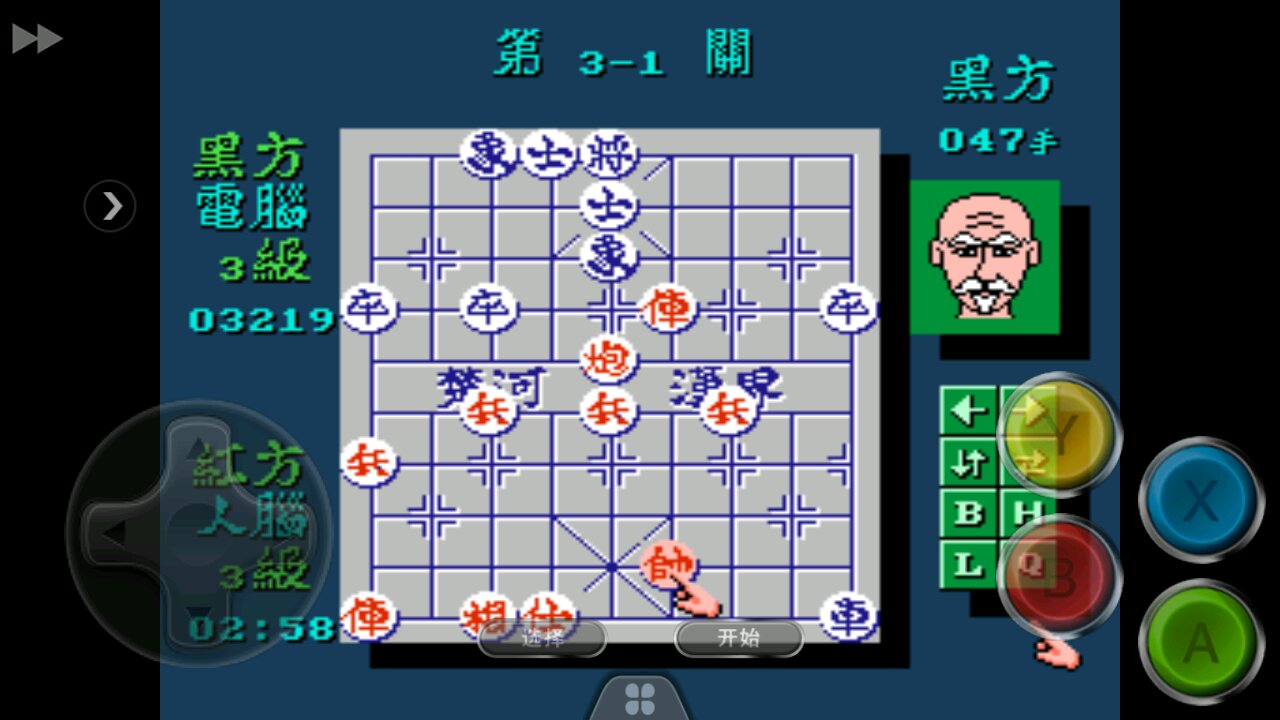背景
小时候在FC上玩过象棋游戏,印象最深的就是那个老头,每次走棋贼慢同时棋力也特高。一直想了解下人机对弈的算法,看了几篇文章后,发现基本的套路都是一样的,自己写了一个小时候玩的两口吃一口的小游戏。

棋类AI基本步骤(以下都是基于两口吃一口这个小游戏)
-
局面生成:棋子种类、开局位置
// 5x5 棋盘,黑方和白方初始时都有5颗棋子 /* 0 1 2 3 4 ┌─────────┐ 0│○─○─○─○─○│ 1│├─┼─┼─┼─┤│ 2│├─┼─┼─┼─┤│ 3│├─┼─┼─┼─┤│ 4│●─●─●─●─●│ └─────────┘ */ std::string GenBoard(int row, int col, int colNum, int rowNum, std::map<std::pair<int, int>, int> board) { std::string str; auto it = board.find(std::make_pair(row, col)); if (it != board.end()) { if (it->second == WHITE) { return "○"; } if (it->second == BLACK) { return "●"; } } if (row == 0 && col == 0) { str = "┌"; } else if (row == 0 && col == colNum - 1) { str = "┐"; } else if (row == rowNum - 1 && col == 0) { str = "└"; } else if (row == rowNum - 1 && col == colNum - 1) { str = "┘"; } else if (row == 0) { str = "┬"; } else if (col == colNum - 1) { str = "┤"; } else if (col == 0) { str = "├"; } else if (row == rowNum - 1) { str = "┴"; } else { str = "┼"; } return str; } // 棋盘绘制 void DrawBoard() { std::string posCol; std::string topBorderLine; std::string bottomBorderLine; posCol += " "; for (int i = 0; i < g_colNum; i++) { posCol += std::to_string(i) + " "; } GenBorderLine(topBorderLine, bottomBorderLine, g_colNum); std::cout << posCol << std::endl; std::cout << topBorderLine << std::endl; for (int rowIdx = 0; rowIdx < g_rowNum; rowIdx++) { std::cout << std::to_string(rowIdx) << "│"; for (int colIdx = 0; colIdx < g_colNum; colIdx++) { std::cout << GenBoard(rowIdx, colIdx, g_rowNum, g_colNum, g_board); if (colIdx != g_colNum - 1) { std::cout << "─"; } } std::cout << "│" << std::endl; } std::cout << bottomBorderLine << std::endl; } -
走法生成:走棋规则、吃子规则、胜利规则
// 上下左右不超出棋盘并且目标位置没有棋子 void GenMoveWays(int player, std::vector<std::tuple<int, int, int, int>>& ways) { int direct[4][2] = { {0, 1}, {1, 0}, {0, -1}, {-1, 0} }; for (auto &i : g_board) { if (i.second != player) { continue; } for (int k = 0; k < 4; k++) { int nextRow = i.first.first + direct[k][0]; int nextCol = i.first.second + direct[k][1]; if (CheckPostion(nextRow, nextCol)) { continue; } auto nextIt = g_board.find(std::make_pair(nextRow, nextCol)); if (nextIt != g_board.end()) { continue; } ways.push_back(std::make_tuple(i.first.first, i.first.second, nextRow, nextCol)); } } } /* 一行或者一列两个连续己方棋子可以吃对方一个棋子 _○○●_:OK ○○●__:OK __○○●:OK ○○●_●:这种情况不能吃子 ○○○●_:这种情况不能吃子 _○○○●:这种情况不能吃子 _●○○●:这种情况不能吃子 ●○○●_:这种情况不能吃子 */ int GetPieceNumByDirect(int row, int col, int direct[2]) { int pieceNum = 0; if (direct[0] != 0 && direct[1] != 0) { std::cout << "错误的方向" << std::endl; assert(0); return 0; } if (direct[0] != 0) { for (int i = 0; i < g_rowNum; i++) { auto it = g_board.find(std::make_pair(i, col)); if (it != g_board.end()) { pieceNum++; } } return pieceNum; } for (int i = 0; i < g_colNum; i++) { auto it = g_board.find(std::make_pair(row, i)); if (it != g_board.end()) { pieceNum++; } } return pieceNum; } // 当前走棋方棋子数量小于2,则为失败(连续两个棋子才能吃对方一个棋子) bool IsCurrentPlayLose() { return GetPieceNum(g_currentPlayer) < 2; } -
局面评估:这部分其实是大多棋类AI的关键,别看我写的局面评估只有一个语句
// 己方棋子越多,对自己越有利 int EvaluatePosition() { return GetPieceNum(WHITE) - GetPieceNum(BLACK); } -
局面搜索:搜索算法要和评估函数结合,通过好的剪枝算法会大大提高AI的智慧,我这里就是一个简单极大极小值深度优先搜索
int GenOneStep(int fromRow, int fromCol, int toRow, int toCol, std::vector<std::pair<int, int>> &eats) { std::set<std::tuple<int, int, int, int>> ways; if (!IsVaildPiece(fromRow, fromCol, toRow, toCol, g_currentPlayer)) { return -1; } // 走一步棋 DeletePiece(fromRow, fromCol, g_currentPlayer); AddPiece(toRow, toCol, g_currentPlayer); // 吃子 EatPiece(toRow, toCol, g_currentPlayer, eats); // 交换走棋方 ChangePlayer(); //DrawBoard(); return 0; } void UndoOneStep(int fromRow, int fromCol, int toRow, int toCol, std::vector<std::pair<int, int>>& eats) { // 还原被吃掉的对方棋子 for (auto& i : eats) { AddPiece(i.first, i.second, g_currentPlayer); // 当前走棋方为对方 } eats.clear(); // 交换走棋方 ChangePlayer(); // 撤销上一步棋 DeletePiece(toRow, toCol, g_currentPlayer); AddPiece(fromRow, fromCol, g_currentPlayer); } int Search(int depth, int& fromRow, int& fromCol, int &toRow, int &toCol) { int bestValue; int value; if (depth == 0) { return EvaluatePosition(); } if (g_currentPlayer == BLACK) { bestValue = INFINITY_VALUE; // bestValue越小对黑方越有利 } else { bestValue = -INFINITY_VALUE; // bestValue越大对白方越有利 } std::vector<std::tuple<int, int, int, int>> ways; std::vector<std::pair<int, int>> eats; GenMoveWays(g_currentPlayer, ways); for (auto& i : ways) { if (GenOneStep(std::get<0>(i), std::get<1>(i), std::get<2>(i), std::get<3>(i), eats)) { continue; } value = Search(depth - 1, fromRow, fromCol, toRow, toCol); UndoOneStep(std::get<0>(i), std::get<1>(i), std::get<2>(i), std::get<3>(i), eats); if (g_currentPlayer == BLACK) { if (value < bestValue) { bestValue = value; if (depth == MAX_SEARCH_DEPTH) { fromRow = std::get<0>(i); fromCol = std::get<1>(i); toRow = std::get<2>(i); toCol = std::get<3>(i); } } } else { if (value > bestValue) { bestValue = value; if (depth == MAX_SEARCH_DEPTH) { fromRow = std::get<0>(i); fromCol = std::get<1>(i); toRow = std::get<2>(i); toCol = std::get<3>(i); } } } } // 当前方已经无棋可走了 if (g_currentPlayer == BLACK && bestValue == INFINITY_VALUE) { // 黑方value越小越好,即搜索深度越深到达无路可走越好 return INFINITY_VALUE - (MAX_SEARCH_DEPTH - depth); } if (g_currentPlayer == WHITE && bestValue == -INFINITY_VALUE) { return (MAX_SEARCH_DEPTH - depth) - INFINITY_VALUE; } return bestValue; } void ComputerOneStep() { int fromRow; int fromCol; int toRow; int toCol; std::vector<std::pair<int, int>> eats; Search(MAX_SEARCH_DEPTH, fromRow, fromCol, toRow, toCol); GenOneStep(fromRow, fromCol, toRow, toCol, eats); }
项目链接
https://github.com/xy007man/2KouChiYiKou